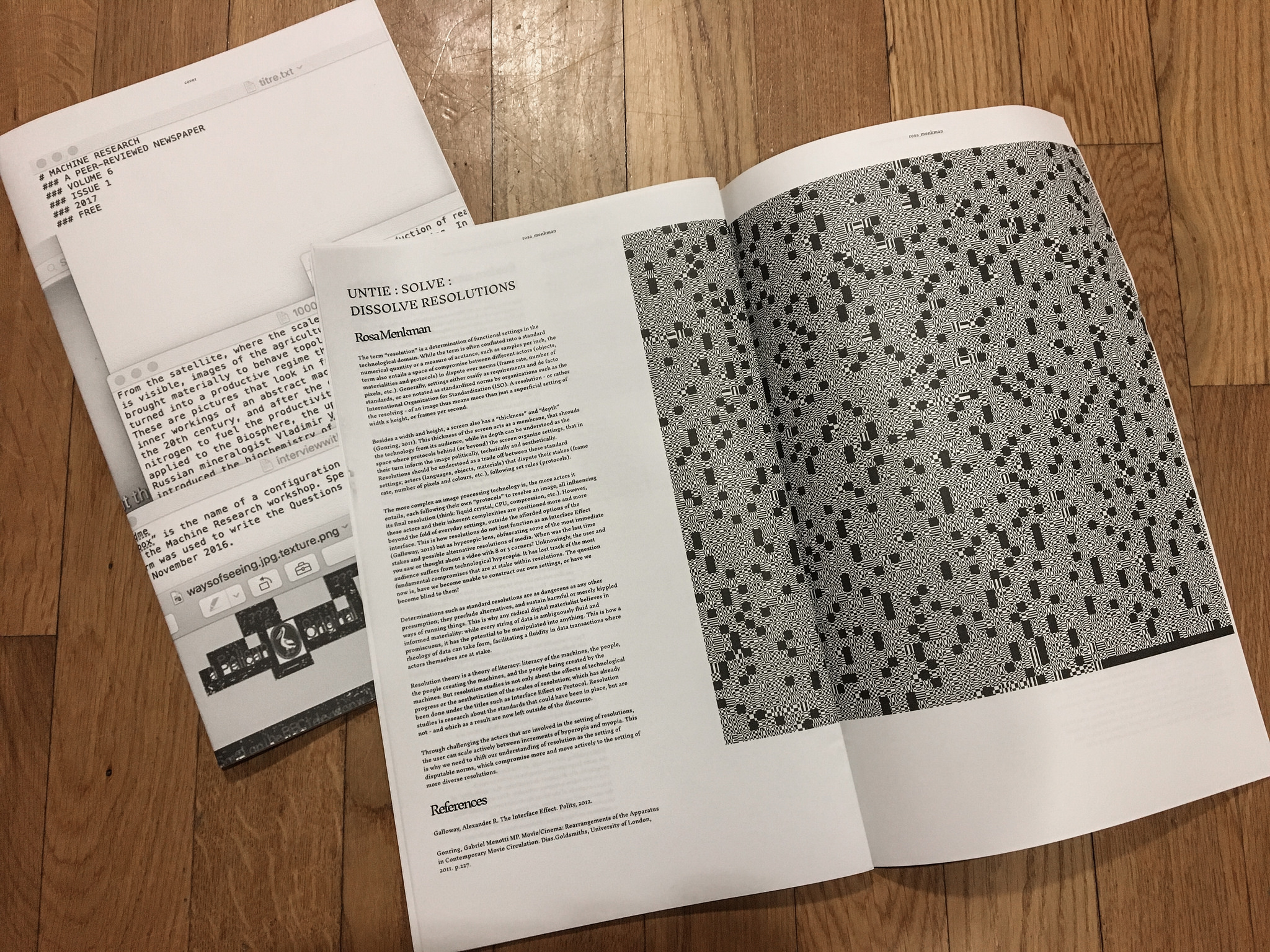 ︎ Untie : Solve : Dissolve : Resolutions for the Transmediale Machine Research publication (2016)
︎ Untie : Solve : Dissolve : Resolutions for the Transmediale Machine Research publication (2016)full final text: Refuse to let the Syntaxes of (a) History Direct our Futures.
In: Fragmentation of the Image (Routledge, 2019)) ed. Daniel Rubinstein. PDF HERE
Notes:
1. Gonring, Gabriel Menotti MP. Movie/Cinema: Rearrangements of the Apparatus in Contemporary Movie Circulation. Diss. Goldsmiths, University of London, 2011. p. 227.
2. Galloway, Alexander R. The interface effect. Polity, 2012.
Untie : Solve : Dissolve : ResolutionsResolutions involve < determinations > /* –and lost alternatives– */
Within the technological realm, the term ‘resolution’ is often simplified, to mean a standard numerical quantity or a measure of acutance, such as samples per inch. In reality, the term refers to settings that function in conjunction and thus entails a space of compromise between different actors (objects, materialities and protocols) in dispute over norms (frame rate, number of pixels, etc.). Generally, settings within these conjunctions either ossify as requirements and de facto standards, or are notated as standardized norms by organizations such as the International Organization for Standardization (ISO).
A resolution - or rather the resolving - of an image thus means more than just a superficial setting of width x height, or frames per second. Besides a width and height, a screen also has a ‘thickness’ and ‘depth’.1 This thickness of the screen acts as a membrane, that shrouds the technology from its audience, while its depth can be understood as the space where protocols behind (or beyond) the screen organize settings, that in their turn inform the image politically, technically and aesthetically. Resolutions should be understood as a trade off between these standard settings; actors (languages, objects, materials) that dispute their stakes (frame rate, number of pixels and colours, etc.), following set rules (protocols).
The more complex an image processing technology is, the more actors it entails, each following their own ‘protocols’ to resolve an image, all influencing its final resolution (think: liquid crystal, CPU, compression, etc.). However, these actors and their inherent complexities are positioned more and more beyond the fold of everyday settings, outside the afforded options of the interface. This is how resolutions do not just function as an Interface Effect but as hyperopic lens, obfuscating some of the most immediate stakes and possible alternative resolutions of media. When was the last time you saw or thought about a video with 8 or 3 corners?
Unknowingly, the user and audience suffers from technological hyperopia. It has lost track of the most fundamental compromises that are at stake within resolutions. The question now is, have we become unable to construct our own settings, or have we become blind to them?
Determinations such as standard resolutions are as dangerous as any other presumption; they preclude alternatives, and sustain harmful or merely kippled ways of running things. This is why any radical digital materialist believes in informed materiality: while every string of data is ambiguously fluid and promiscuous, it has the potential to be manipulated into anything. This is how a rheology of data can take form, facilitating a fluidity in data transactions where actors themselves are at stake.
Resolution theory is a theory of literacy: literacy of the machines, the people, the people creating the machines, and the people being created by the machines. But resolution studies is not only about the effects of technological progress or the aesthetization of the scales of resolution; which has already been done under the titles such as Interface Effect or Protocol.2 Resolution studies is research about the standards that could have been in place, but are not - and which as a result are now left outside of the discourse.
Through challenging the actors that are involved in the setting of resolutions, the user can scale actively between increments of hyperopia and myopia. This is why we need to shift our understanding of resolution, and see them as disputable norms or habitual compromises.
A protocol shapes data in order for it to be stored, shown, or move and connect between technologies. Protocols, together with objects and their materialities, form the resolutions that make technology run smoothly.3 But these resolutions form not only a solution, but also a compromise between multiple underlying media properties. A resolution is not a neutral facility but carries historical, economical and political ideologies. The cost of all of these media protocols is that we have gradually become unaware of the choices and compromises they represent. We are collectively suffering from technological hyperopia where these qualities have moved beyond a fold of perspective.
Have we become bad at constructing our own resolutions, or are we just oblivious to resolutions and their inherent compromises?
